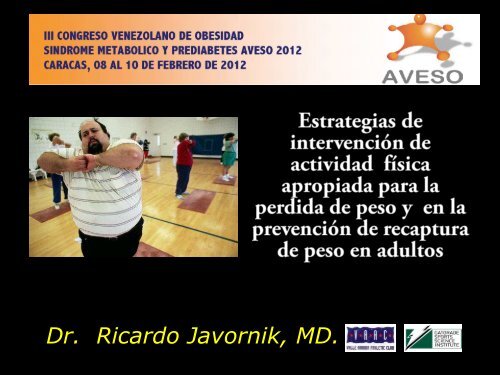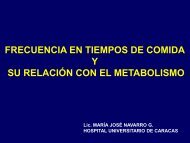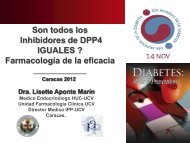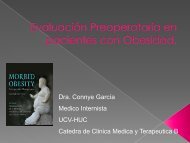Create successful ePaper yourself
Turn your PDF publications into a flip-book with our unique Google optimized e-Paper software.
Dr. Ricardo Javornik, MD.
Dr. Ricardo Javornik K. MD<br />
javornikenator@gmail.com<br />
�Médico, Universidad de Carabobo, Venezuela<br />
�Medicina del Deporte, Universidad de Roma,<br />
Italia.<br />
�Miembro profesional del Colegia Americano de<br />
Medicina del Deporte<br />
� Gerente Médico del Valle Arriba Athletic Club.<br />
� Director Médico GSSI-Venezuela.<br />
�Facilitador para la Red de Actividad Física para<br />
las Americas, OPS.
Dr. Ricardo Javornik, MD.
Lineamientos para la prescripción de ejercicio físico<br />
en el sobrepeso y la obesidad.<br />
Contenido<br />
• Introducción.<br />
• Sobrepeso y obesidad.<br />
• �A.F. � Control de peso.<br />
• A.F.�� de peso.<br />
• A.F. � Prevención en la recaptura<br />
de peso.<br />
• ¨ Solo dieta¨ vs ¨Dieta + A.F.¨.<br />
• A.F.D. �� de peso.<br />
• Adherencia.<br />
• Conclusiones y recomendaciones.
Musculo como órgano endocrino<br />
• Reservorio:<br />
- Glucosa- Triglicéridos<br />
• Quemador:<br />
-Acidos grasos��Triglíceridos<br />
• A distancia:<br />
-� HDL plasmático (lecitin coleterolacyltransferasa)
Valores de IL-6 con diversos tipos de ejercicios
Relacion entre tiempo y concentración de la IL-6<br />
Pedersen BK, Fischer CP. Beneficial health effects of exercise: the role of IL-6 as a myokine. Trends Pharmacol Sci 28: 152–156,2007.
Rol biológico de la IL-6 liberadas por la contracción muscular:<br />
Pedersen BK, Fischer CP. Beneficial health effects of exercise: the role of IL-6 as a myokine. Trends Pharmacol Sci 28: 152–156,2007.
Joseph E. Donnelly, Ed.D. (Chair); Steven N.Blair, PED; John M. Jakicic,<br />
Ph.D.; Melinda M. Manore, Ph.D., R.D.; Janet W. Rankin, Ph.D.; and Bryan K.<br />
Smith, Ph.D.
Determinantes del sobrepeso/obesidad<br />
(Conductuales, biológicos, metabólicos)<br />
Estado socio-económica<br />
(Educación)<br />
Actividad física<br />
Nutrición<br />
Cigarrillo<br />
Factores genéticos<br />
OBESIDAD<br />
Y<br />
SOBREPESO<br />
Raza<br />
Genero<br />
Edad<br />
Embarazo<br />
Factores endocrinos<br />
y metabolicos
Fórmula de balance energético<br />
CONSUMO<br />
Cantidad<br />
Composición<br />
Frecuencia<br />
GASTO<br />
CALORICO<br />
Met. Basal<br />
Ejercicio<br />
Peso Corporal
100%<br />
90%<br />
80%<br />
70%<br />
60%<br />
50%<br />
40%<br />
30%<br />
20%<br />
10%<br />
ADEA AFE 0%<br />
Componentes del G.C. Diario<br />
AFV<br />
AFE<br />
ADEA<br />
MB<br />
Intensidad.<br />
Duración.<br />
Peso corporal.<br />
Genetica &SNC?.<br />
Cant.&Cal alimentos.<br />
Masa libre de grasa.<br />
Edad.<br />
Género.<br />
Hormonas.<br />
Genética.<br />
MB
IMC: PESO(Kg)/TALLA 2 (mt)
4<br />
3<br />
2<br />
1<br />
0<br />
Riesgo<br />
moderado<br />
Sobrepeso y obesidad<br />
Niveles de riesgo de acuerdo al Indice de masa corporal<br />
Riesgo<br />
bajo<br />
Riesgo<br />
moderado<br />
16 20 25 30 40<br />
INDICE DE MASA CORPORAL<br />
Riesgo<br />
alto
Sobrepeso y obesidad<br />
Riesgo relativo de problemas de salud relativos al<br />
sobrepeso y obesidad<br />
Incremento marcado<br />
(R .<strong>Relativo</strong> >3)<br />
Diabetes mellitus No<br />
insulino dependinte<br />
Dislipidemia<br />
Resistencia a la insulina<br />
Falta de aire<br />
Apnea del sueño<br />
Incremento moderado<br />
(R. <strong>Relativo</strong> >2,5)<br />
Enfermedad<br />
cardiovascular<br />
Osteoartritis (Rodilla)<br />
Hiperuricemia y gota<br />
Incremento ligero<br />
(R. <strong>Relativo</strong> >2)<br />
Ciertos tipos de cáncer<br />
S. Ovario poliquístico<br />
� fertilidad<br />
Dolor de espalda baja<br />
Defectos fetales
Indice de masa corporal en hombres entre 15 y 100<br />
años, 2010,OMS<br />
PAIS IMC Nº<br />
Estados unidos 29.3 1<br />
Argentina 28.7 2<br />
México 27.8 3<br />
Venezuela 27.8 4<br />
Dominica 27.3 5<br />
Uruguay 27.3 6<br />
Chile 27.1 7<br />
Cánada 27.0 8<br />
Barbados 26.8 9<br />
Cuba 26.6 10<br />
Trinidad y Tobago 26.6 11<br />
Guatemala 26.5 12<br />
Colombia 26.5 13<br />
Bolivia 26.4 14<br />
Peru 26.2 15/35
Prevalencia sobrepeso/obesidad en hombres entre<br />
15 y 100 años, 2010, OMS<br />
PAIS PREVALENCIA Nº<br />
Estados Unidos 80.5 1<br />
Argentina 77.7 2<br />
Venezuela 74.4 3<br />
Mexico 73.6 4<br />
Dominica 70.8 5<br />
Uruguay 69.3 6<br />
Chile 68.4 7<br />
Canada 66.9 8<br />
Cuba 65.4 9<br />
Trinidad/Tobago 65.2 10<br />
Barbados 65.1 11<br />
Guatemala 62.9 12<br />
Colombia 62.6 13<br />
Bolivia 62.4 14<br />
Peru 60.9 15/35
Prevalencia obesidad en hombres entre 15 y 100 años,<br />
2010, OMS<br />
PAIS PREVALENCIA Nº<br />
Estados Unidos 44.2 1<br />
Argentina 37.4 2<br />
México 30.1 3<br />
Venezuela 29.5 4<br />
Dominica 25.8 5<br />
Uruguay 25.7 6<br />
Canada 25.5 7<br />
Chile 24.3 8<br />
Barbados 22.0 9<br />
Guatemala 20.5 10<br />
Cuba 20.1 11<br />
Colombia 19.6 12<br />
Bolivia 19.4 13<br />
Trinidad/ Tobago 19.1 14<br />
Peru 17.7 15/35
Indice de masa corporal en mujeres<br />
entre 15 y 100 años, 2010,OMS<br />
PAIS BMI POSICION<br />
Barbados 31.3 1<br />
Trinidad and Tobago 30.6 2<br />
Dominica 30.6 3<br />
Estados unidos 29.9 4<br />
Jamaica 29.8 5<br />
Santa Lucia 28.9 6<br />
Mexico 28.9 7<br />
Nicaragua 28.9 8<br />
Bolivia 28.7 9<br />
Chile 28.5 10<br />
R. Dominicana 28.5 11<br />
Argentina 28.5 12<br />
Guatemala 28.2 14<br />
Venezuela 27.7 15/35
Prevalencia de sobrepeso /obesidad en mujeres<br />
entre 15 y 100 años, 2010, OMS<br />
PAIS PREVAL. POSICION<br />
Barbados 83.3 1<br />
Dominica 80.8 2<br />
Trinidad/Tobago 80.8 3<br />
Jamaica 79.0 4<br />
Estados Unidos 76.7 5<br />
Santa Lucia 74.1 6<br />
Chile 73.3 7<br />
Bolivia 73.2 8<br />
Nicaragua 73.1 9<br />
Mexico 73.0 10<br />
R. Dominicana 71.7 11<br />
Argentina 71.2 12<br />
Guatemala 70.9 13<br />
Peru 70.1 14<br />
Venezuela 67.3 15/35
Prevalencia de Obesidad en mujeres entre 15 y 100<br />
años, 2010, OMS<br />
PAIS PREVALENCIA Nº<br />
Barbados 57.2 1<br />
Trinidad/Tobago 52.7 2<br />
Dominica 52.6 3<br />
Jamaica 48.3 4<br />
Estados Unidos 48.3 5<br />
Saint Lucia 41.7 6<br />
Nicaragua 41.1 7<br />
Mexico 41.0 8<br />
Bolivia 40.2 9<br />
Chile 39.1 10<br />
R. Dominicana 38.7 11<br />
Argentina 37.8 12<br />
Peru 37.7 13<br />
Guatemala 36.8 14<br />
Venezuela 33.0 15/35
DOSIFICACION (FDA, 1994)<br />
Ejercicio<br />
�Intensidad<br />
�Duración<br />
� Frecuencia<br />
� Calorías
Relación entre los indicadores de la<br />
intensidad del ejercicio<br />
%MFC %RFC Borg Intensidad<br />
Intensidad del esfuerzo<br />
INTENSIDAD VALOR ( METS)<br />
BAJA 1,1 A 2,9<br />
MODERADA 3,0 A 5,9<br />
ALTA > 6<br />
PERSONA DE 90 KGS<br />
VELOCIDAD METS<br />
4 KM 2,5 A 3,0<br />
5 KM 3,0 A 4,5<br />
6 KM 5 A 6,5
Duración y frecuencia del esfuerzo<br />
Progresión � 0 a 18 semanas<br />
�30 a 60-90 minutos -1<br />
�3 a 7 veces semana -1<br />
AMERICAN C0LLEGGE OF SPORTMEDICINE:Quantity and Quality of Exercise for Developinga nd Maintaining Cardiorespiratory, Musculoskeletal,<br />
and Neuromotor Fitness in Apparently Healthy Adults: Guidance for Prescribing Exercise.MSSE 2011: 2345-2386:32<br />
AMERICAN C0LLEGGE OF SPORTMEDICINE: Exercise and diabetes Type 2.MSSE 2010: 2282-2304:31.<br />
AMERICAN C0LLEGGE OF SPORTMEDICINE Appropriate Physical Activity Intervention Strategies for Weight Lossand Prevention of Weight<br />
Regain for Adults.2009:459-486:29
Calorías<br />
• Medición directa??<br />
• Medición indirecta:<br />
- Tablas<br />
- Cardiotacómetros
Evolución del peso: Alerta clínica<br />
• Sherwood et al.:<br />
• ♂: 40.1±9;♀:42,8±8<br />
• 3 años de control<br />
• 826 F, 218 M<br />
• ♂:~3,1♀:~ 4,8 kg.<br />
• 47%=, 35% �,18 %�<br />
St.Jeor et a..: A classification system to evaluate weight maintainers, gainers, and losers. J Am Diet Assoc. 1997 May;97(5):481-8.<br />
Sherwood NE et al.: Predictors of weight gain in the Pound of Prevention study. Int J Obes Relat Metab Disord. 2000 Apr;24(4):395-<br />
403.<br />
Mantenimiento:<br />
3%<br />
• St Jeor et al.:<br />
• 44.1±14,1<br />
• 5 años de control<br />
• 385 personas<br />
• Patrón:2,5 kg<br />
• 46%=, 34% �,20 %�<br />
Cambio significativo:<br />
5%
Prevención del aumento de peso<br />
Evidencia Categoria A<br />
150 a 250 min • sem -1 ; 1200 a<br />
2000 calorias • sem -1<br />
Previenen ganancias de peso<br />
de más de 3% en adultos.<br />
Berk DR, Hubert HB, Fries JF. Associations of changes in exercise level with subsequent ….J Gerontol A Biol Sci Med Sci. 2006; 61:97–102.<br />
Kavouras SA, Panagiotakos DB, Pitsavos C, et al. Physical activity, obesity status, and glycemic.. Med Sci Sports Exerc. 2007;39(4):606–11.<br />
McTiernan A, Sorensen B, Irwin ML, et al. Exercise effect on weight and body fat in men and women…………... Obesity. 2007; 15:1496–512.
Reducción significativa de peso<br />
Evidencia Categoria B<br />
�AF >150 min • semana -1 � �<br />
moderadas de peso de ≈3 a 5 kg.<br />
�AF > 225-420 min • semana -1 �<br />
� de peso entre 5 y 7 kilogramos.<br />
Patrón de � 3-5% peso.<br />
�Presencia de patrón de dosis<br />
respuesta.<br />
Donnelly JE, et al(1):The effects of 18 months of intermittent vs continuous exercise on aerobic… Int J Obes Relat Metab Disord. 2000;24:566–72.<br />
Ross R, et al (2):. Effects of energy restriction and exercise on skeletal muscle and adipose tissue in women ……Am J Clin Nutr.1995;61:1179–85.<br />
Donnelly JE et al(3). Effects of a 16-month randomized controlled exercise trial on body weight and compo.... Arch Intern Med. 2003;163:1343–50.<br />
Garrow JS, Summerbell CD(4) Meta-analysis: effect of exercise,with or without dieting, on the body composition of..Eur J Clin Nutr. 1995;49:1–10.<br />
Wing R. Physical activity in the treatment of the adulthood overweight and obesity: current evidence …….Med Sci Sports Exerc. 1999;31:S547–52.
AF en prevención en la recaptura<br />
de peso. Evidencia Categoria B<br />
�Mayoría de estudios soportan que ~200<br />
a 300 min • sem -1 son suficientes para<br />
mantener el nivel obtenido y evitar<br />
que la recaptura de peso ( >3%)<br />
�Presencia de patrón de<br />
dosis respuesta.<br />
Andersen RE, et al-. Effects of lifestyle activity vs structured aerobic exercise in obese women……………………….. JAMA. 1999;281:335–40.<br />
Ewbank PP.: Physical activity as a predictorof weight maintenance in previously obese subjects………………….. ObesRes. 1995;3(3):257–63.<br />
Jakicic JM.; Effect of exercise on 24-month weight loss maintenance in overweight women……….. Arch Intern Med. 28;168(14):1550-9, 2008.<br />
Jakicic JM, Clark K, Coleman E, et al. Appropriate intervention strategies for weight loss and……Med Sci Sports Exerc. 2001;33(12):2145–56.<br />
Jeffery RW, Wing RR, Sherwood NE, Tate DF. Physical activity and weight loss: does prescribing higher ……. Am J Clin Nutr. 2003;78:684–9.
Dieta sola vs. Ejercicio + dieta<br />
Evidencia Categoria B<br />
� Dieta sola baja de peso<br />
� Dieta + Ejercicio : Efecto aditivo<br />
< 800 calorias� � 5 a 10%<br />
� Dieta + Ejercicios: R. Severa:<br />
menos perdida.<br />
Curioni CC, Lourenco PM. Long-term weight loss after diet and exercise: a systematic review…………………………. Int J Obes. 2005;29:1168–74.<br />
Donnelly JE, et al Effects of a very-low-calorie diet and physical-training regimens on body composition …………….Am J Clin Nutr. 1991;54:56–61.<br />
Evans EM, el alEffects of diet and exercise on the density and composition of the fat-free mass……… Med Sci Sports Exerc. 1999;31(12):1778–87.<br />
Hays NP et al. Effects of an ad libitum lowfat, high-carbohydrate diet on body weight, body composition,………… Arch Intern Med. 2004;164:210–7.<br />
Janssen I,,:Effects of an energyrestrictive diet with or without exercise on abdominal fat, intermuscular fat, and …… Diabetes Care. 2002;25:431–8.
Perdida de peso y actividades<br />
de la vida diaria Evidencia Categoria B<br />
• Sedentarismo en trabajo, casa,<br />
diversión.<br />
• BE+:90-100 cal•dia -1 �Epi. Obesidad.<br />
• Podómetros, cuestionarios,<br />
autoreportes.<br />
• 11 Inves: Más movimiento��ganancia<br />
de peso.<br />
• Utilidad evidente en evitar el �peso no<br />
para su reducción.<br />
Cooper AR et al.:Physical activity patterns in normal, overweight and obese individuals using minute…..Eur J Clin Nutr. 2000;54: 887–94.<br />
U.S. Department of Health and Human Services. Physical Activ.U.S. Government Printing Office, Public Health Service; December 1998.<br />
Wadden TA, et al: Lifestyle modification for the management of obesity. ……………………………..Gastroenterology. 2007;132:2226–38.<br />
Wadden TA, Berkowitz RI, Wo, et al. Randomized trial of lifestyle modification and …………………….N Engl J Med. 2005;353:2111–20.
ADHERENCIA�SOBREPESO/OBESIDAD<br />
~30%<br />
Blackburn GL.:Multidisciplinary approach to adult obesity therapy. I………………….Int J Obes. 1978;2(2):133-42.1978<br />
Turk MW. El al: Randomized clinical trials of weight loss maintenance: a review. J Cardiovasc Nurs.24(1):58-80.2009<br />
Schelling S. et al.: Increasing the motivation for physical activity in obese patients. Int J Eat Disord. ;42(2):130-8.2009
ADHERENCIA�SOBREPESO/OBESIDAD<br />
• Entrenamientos.<br />
• ¿A dónde voy?<br />
• Resultados<br />
• Corrección y ajuste<br />
• Soporte<br />
Blackburn GL.:Multidisciplinary approach to adult obesity therapy. I………………….Int J Obes. 1978;2(2):133-42.1978<br />
Turk MW. El al: Randomized clinical trials of weight loss maintenance: a review. J Cardiovasc Nurs.24(1):58-80.2009<br />
Schelling S. et al.: Increasing the motivation for physical activity in obese patients. Int J Eat Disord. ;42(2):130-8.2009
ADHERENCIA�SOBREPESO/OBESIDAD<br />
Entrenamientos<br />
• Divertido y conveniente<br />
• Horario adecuado.<br />
• Progresión lenta:<br />
- Intensidad<br />
- Duración<br />
• Individualizar<br />
• Compañero semejante<br />
Blackburn GL.:Multidisciplinary approach to adult obesity therapy. I………………….nt J Obes. 1978;2(2):133-42.1978<br />
Castellani w. Adherence to structured physical exercise in overweight………….. Eat Weight Disord. 2003 8(1):1-11<br />
Schelling S. et al.: Increasing the motivation for physical activity in obese patients. Int J Eat Disord. ;42(2):130-8.2009
ADHERENCIA�SOBREPESO/OBESIDAD<br />
¿A donde voy?<br />
• Metas realistas.<br />
• Objetivos precisos.<br />
Blackburn GL.:Multidisciplinary approach to adult obesity therapy. I………………….nt J Obes. 1978;2(2):133-42.1978<br />
Turk MW. El al: Randomized clinical trials of weight loss maintenance: a review. J Cardiovasc Nurs.24(1):58-80.2009<br />
Schelling S. et al.: Increasing the motivation for physical activity in obese patients. Int J Eat Disord. ;42(2):130-8.2009
ADHERENCIA�SOBREPESO/OBESIDAD<br />
Resultados<br />
• Tangibles:<br />
- Antropométricos.<br />
- Laboratorio.<br />
• Fisiológicos:<br />
- Eficiencia Cardiovascular.<br />
• Intangibles:<br />
- Sueño.<br />
- Energía<br />
- Dominio<br />
Blackburn GL.:Multidisciplinary approach to adult obesity therapy. I………………….nt J Obes. 1978;2(2):133-42.1978<br />
Turk MW. El al: Randomized clinical trials of weight loss maintenance: a review. J Cardiovasc Nurs.24(1):58-80.2009<br />
Schelling S. et al.: Increasing the motivation for physical activity in obese patients. Int J Eat Disord. ;42(2):130-8.2009
ADHERENCIA�SOBREPESO/OBESIDAD<br />
Correción y Ajuste<br />
• Sin ganas � haga �<br />
motivación.<br />
• Pérdida de entrenamiento<br />
� perdón � reajuste<br />
estrategias.<br />
• Plan alterno.<br />
• No cumplimiento �<br />
revaluar � reorganizar.<br />
Blackburn GL.:Multidisciplinary approach to adult obesity therapy. I………………….Int J Obes. 1978;2(2):133-42.1978<br />
Turk MW. El al: Randomized clinical trials of weight loss maintenance: a review. J Cardiovasc Nurs.24(1):58-80.2009<br />
Schelling S. et al.: Increasing the motivation for physical activity in obese patients. Int J Eat Disord. ;42(2):130-8.2009
ADHERENCIA�SOBREPESO/OBESIDAD<br />
Soporte<br />
• Soporte social<br />
• Compañero, entrenador<br />
o clase en grupo<br />
• Esposa, familia, amigos.<br />
• Actividad semanal con la<br />
familia.<br />
• Importancia de la actividad<br />
Blackburn GL.:Multidisciplinary approach to adult obesity therapy. I………………….nt J Obes. 1978;2(2):133-42.1978<br />
Turk MW. El al: Randomized clinical trials of weight loss maintenance: a review. J Cardiovasc Nurs.24(1):58-80.2009<br />
Schelling S. et al.: Increasing the motivation for physical activity in obese patients. Int J Eat Disord. ;42(2):130-8.2009
CONCLUSIONES<br />
• El sobrepeso y la obesidad están en<br />
franco aumento � Niveles<br />
epidémicos.<br />
• Reconocerlos como factor de riesgo<br />
y la necesidad de trabajarlos.<br />
• A.F. moderada: Intensidad<br />
adecuada.<br />
• A.F: 30 a 45 minutos previene el<br />
�de peso.
CONCLUSIONES<br />
• AF: > 60 minutos diarios<br />
�peso.<br />
• AF: 60 minutos diarios + �<br />
calórica 500�Efecto aditivo<br />
• Act. de vida diaria�previenen<br />
aumento.
CONCLUSIONES<br />
• Seguir técnicas y<br />
lineamientos para la<br />
adherencia los<br />
programas de pérdida<br />
de peso permiten<br />
obtener y mantener<br />
mejores resultados.
Aportar información<br />
científica actualizada<br />
en las ciencias del<br />
deporte
Muchas<br />
Gracias<br />
por su<br />
atención








